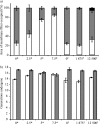Heterogeneous selection in a spatially structured environment affects fitness tradeoffs of plasmid carriage in pseudomonads
- PMID: 18378654
- PMCID: PMC2394952
- DOI: 10.1128/AEM.02383-07
Heterogeneous selection in a spatially structured environment affects fitness tradeoffs of plasmid carriage in pseudomonads
Abstract
Environmental conditions under which fitness tradeoffs of plasmid carriage are balanced to facilitate plasmid persistence remain elusive. Periodic selection for plasmid-encoded traits due to the spatial and temporal variation typical in most natural environments (such as soil particles, plant leaf and root surfaces, gut linings, and the skin) may play a role. However, quantification of selection pressures and their effects is difficult at a scale relevant to the bacterium in situ. The present work describes a novel experimental system for such fine-scale quantification, with conditions designed to mimic the mosaic of spatially variable selection pressures present in natural surface environments. The effects of uniform and spatially heterogeneous mercuric chloride (HgCl(2)) on the dynamics of a model community of plasmid-carrying, mercury-resistant (Hg(r)) and plasmid-free, mercury-sensitive (Hg(s)) pseudomonads were compared. Hg resulted in an increase in the surface area occupied by, and therefore an increase in the fitness of, Hg(r) bacteria relative to Hg(s) bacteria. Uniform and heterogeneous Hg distributions were demonstrated to result in different community structures by epifluorescence microscopy, with heterogeneous Hg producing spatially variable selection landscapes. The effects of heterogeneous Hg were only apparent at scales of a few hundred micrometers, emphasizing the importance of using appropriate analysis methods to detect effects of environmental heterogeneity on community dynamics. Heterogeneous Hg resulted in negative frequency-dependent selection for Hg(r) cells, suggesting that sporadic selection may facilitate the discontinuous distribution of plasmids through host populations in complex, structured environments.
Figures





Similar articles
-
Determining the effects of a spatially heterogeneous selection pressure on bacterial population structure at the sub-millimetre scale.Microb Ecol. 2010 Nov;60(4):873-84. doi: 10.1007/s00248-010-9687-5. Epub 2010 May 29. Microb Ecol. 2010. PMID: 20512486
-
Plasmid stability is enhanced by higher-frequency pulses of positive selection.Proc Biol Sci. 2018 Jan 10;285(1870):20172497. doi: 10.1098/rspb.2017.2497. Proc Biol Sci. 2018. PMID: 29321301 Free PMC article.
-
Migration promotes plasmid stability under spatially heterogeneous positive selection.Proc Biol Sci. 2018 May 30;285(1879):20180324. doi: 10.1098/rspb.2018.0324. Proc Biol Sci. 2018. PMID: 29794045 Free PMC article.
-
Frequency-dependent advantages of plasmid carriage by Pseudomonas in homogeneous and spatially structured environments.ISME J. 2007 May;1(1):92-5. doi: 10.1038/ismej.2007.11. ISME J. 2007. PMID: 18043617
-
Bacterial resistances to inorganic mercury salts and organomercurials.Plasmid. 1992 Jan;27(1):4-16. doi: 10.1016/0147-619x(92)90002-r. Plasmid. 1992. PMID: 1311113 Review.
Cited by
-
Indirect Fitness Benefits Enable the Spread of Host Genes Promoting Costly Transfer of Beneficial Plasmids.PLoS Biol. 2016 Jun 7;14(6):e1002478. doi: 10.1371/journal.pbio.1002478. eCollection 2016 Jun. PLoS Biol. 2016. PMID: 27270455 Free PMC article.
-
Non-invasive determination of conjugative transfer of plasmids bearing antibiotic-resistance genes in biofilm-bound bacteria: effects of substrate loading and antibiotic selection.Appl Microbiol Biotechnol. 2013 Jan;97(1):317-28. doi: 10.1007/s00253-012-4179-9. Epub 2012 Jun 6. Appl Microbiol Biotechnol. 2013. PMID: 22669634 Free PMC article.
-
Persisting uropathogenic Escherichia coli lineages show signatures of niche-specific within-host adaptation mediated by mobile genetic elements.Cell Host Microbe. 2022 Jul 13;30(7):1034-1047.e6. doi: 10.1016/j.chom.2022.04.008. Epub 2022 May 10. Cell Host Microbe. 2022. PMID: 35545083 Free PMC article.
-
Environmentally co-occurring mercury resistance plasmids are genetically and phenotypically diverse and confer variable context-dependent fitness effects.Environ Microbiol. 2015 Dec;17(12):5008-22. doi: 10.1111/1462-2920.12901. Epub 2015 Jun 25. Environ Microbiol. 2015. PMID: 25969927 Free PMC article.
-
Why are rhizobial symbiosis genes mobile?Philos Trans R Soc Lond B Biol Sci. 2022 Jan 17;377(1842):20200471. doi: 10.1098/rstb.2020.0471. Epub 2021 Nov 29. Philos Trans R Soc Lond B Biol Sci. 2022. PMID: 34839705 Free PMC article.
References
-
- Bailey, M. J., A. K. Lilley, I. P. Thompson, P. B. Rainey, and R. J. Ellis. 1995. Site directed chromosomal marking of a fluorescent pseudomonad isolated from the phytosphere of sugar beet: stability and potential for marker gene transfer. Mol. Ecol. 4:755-763. - PubMed
-
- Becker, J. M., T. Parkin, C. H. Nakatsu, J. D. Wilbur, and A. Konopka. 2006. Bacterial activity, community structure, and centimeter-scale spatial heterogeneity in contaminated soil. Microb. Ecol. 51:220-231. - PubMed
-
- Bjorkman, J., and D. I. Andersson. 2000. The cost of antibiotic resistance from a bacterial perspective. Drug Resist. Updates 3:237-245. - PubMed
-
- Brim, H., S. C. McFarlan, J. K. Fredrickson, K. W. Minton, M. Zhai, L. P. Wackett, and M. J. Daly. 2000. Engineering Deinococcus radiodurans for metal remediation in radioactive mixed waste environments. Nat. Biotechnol. 18:85-90. - PubMed
Publication types
MeSH terms
Substances
LinkOut - more resources
Full Text Sources
Medical

